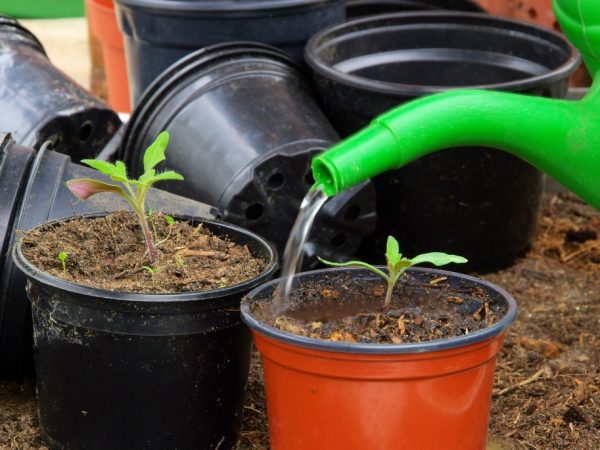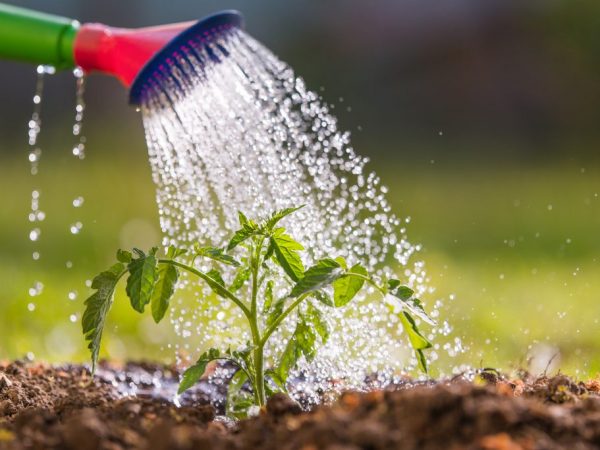Watering rules for tomatoes
It is important for gardeners to know how to water tomatoes correctly, since this crop is demanding on soil moisture. In addition, at each stage of the development of vegetables, the irrigation scheme has its own nuances. Consider how to water tomatoes in the open field and in a greenhouse to get tasty fruits and reap a bountiful harvest.

Watering rules for tomatoes
Humidity requirements
This culture loves moist soil, but has a negative attitude towards high air humidity (if the first indicator can reach 90%, then the second should not exceed 50%). Excessively dry soil causes wilting of leaves and shedding of ovaries, leading to the appearance of apical rot and cracks on ripening fruits.
Excessive moisture also has negative consequences: the fruits become watery and can crack, the roots rot, the plant is exposed to the threat of fungal diseases.
Proper and timely watering of tomatoes allows them to comfortably endure the heat of a summer day: the constant moisture of the soil promotes rapid evaporation through the leaves, as a result of which the tomatoes are cooled. When calculating how much water plantings will need, it is worth remembering that the abundance and frequency of watering tomatoes depends on weather conditions and soil characteristics. On average, it is recommended to moisturize this crop abundantly, but not too often: once a week, using 1 to 5 liters of water (depending on the period of plant development).
When growing tomatoes, it does not make sense to moisten the soil often and little by little, since their root system extends deeper, water will remain in the upper layer of the earth and will not reach the roots.
Watering at different stages of growth
When transplanting tomatoes into open ground, it is necessary to thoroughly moisten the soil, using a liter of water for each well. Once the plants are planted, they should not be disturbed for a week. Further, tomatoes are watered at a frequency of 1 time per week (or 10 days, depending on weather conditions).
During the growth of seedlings and during flowering, 1-2 liters of water are used per plant, after the beginning of fruiting - 3-5 liters. At the stage of mass fruiting, agricultural technicians recommend increasing the number of irrigations up to 2 times a week. On a hot day, tomatoes should be watered in the evening, a few hours before sunset. If the weather is cloudy, you can water the tomatoes at any time, but better in the morning.
How to water
How to properly water tomato plantings and what kind of water to use? Watering tomatoes is carried out at the root (or along the grooves), making sure that water does not fall on the stems and leaves. In summer (especially in July and August), the hot sun can burn the plant: in this case, water droplets on the leaves act like a lens. In this regard, for proper watering of tomatoes, it is better not to use sprinkling, especially from above. In addition, the water pressure during root irrigation should not be too strong, otherwise the jet will wash out the soil and deprive the roots of the nutrient medium.
What should be the water

Rainwater is ideal for irrigation
Water the tomatoes correctly with lukewarm water. It is best to take rainwater and warm it up in the sun to 22-25 ° C. Since rainwater is not always available, agricultural technicians often recommend watering tomatoes with softened water. To do this, add a little compost or weed to the barrel, after which the water is defended for a day or two. Do not use well water to humidify: it may be too cold and harm the root system.
Tatiana Orlova (Candidate of Agricultural Sciences):
Water from the well (from underground sources) before watering all garden plants, including tomato, must also be defended for several days in a separate container to saturate it with oxygen and raise the temperature.
Outdoor watering
Watering tomatoes outdoors requires the water temperature to be no lower than the temperature of the soil itself. The soil should not be too dense or too loose: in the first case, the water will remain in the upper layers of the soil, without reaching the root system, and in the second, it will quickly pass through the ground and will not have time to fully nourish the roots. To prevent moisture from evaporating from the soil so quickly, you can resort to mulching the beds with dry grass or compost.
Greenhouse watering
How to properly water greenhouse tomatoes? The basic rules remain the same, but after each humidification, the greenhouse is thoroughly ventilated.
Watering greenhouse tomatoes is advised from a barrel installed directly in the greenhouse. This allows you to maintain the required temperature of separated water. Moreover, if a barrel of water is placed in a greenhouse, it must be closed, otherwise the air humidity inside will exceed the norm.
Watering seedlings
How often should seedlings be watered? For the first time, the soil is moistened with warm water 3 days after the emergence of tomato shoots. You can use a small glass or just a spoon, irrigation is also permissible, but provided that water droplets do not fall on the leaves of the plants. Further, it is recommended to moisten the soil as it dries, and also two days before diving.
Watering dived tomatoes is done four days after transplanting. The frequency of moistening after a dive is once a week, if the soil dries up well enough. Shortly before transplanting into open ground, you can use the method of moistening the roots from the pallet: the roots will reach for moisture, which will contribute to their growth and development. Before transplanting, the soil in each pot must be thoroughly moistened: this will help protect the root system from possible damage.
Additional recommendations
- How to understand how much moisture is present in the soil and is it enough for the full growth of tomatoes? You need to dig the earth to a depth of 10 cm, then take a lump of soil for a sample, squeeze it with your palm. If the soil sticks together in your hand and then crumbles easily, the soil is moistened normally.
- Before moistening the soil, make sure that the water is used without harmful impurities. In particular, you cannot take water from a rusty barrel: this will harm not only the growth of tomatoes, but also the people who will consume them.
- 3-4 times during the whole season it is recommended to use water with ash to moisten the soil. Such dressings are especially useful for tomatoes: they enrich the soil with minerals (no nitrogen), improve its structure and serve as a good prevention of fungal diseases.
- For good growth, gardeners recommend watering tomatoes with yeast infusion. The solution is prepared at the rate of 1 kg per 5 liters of water, infused for a day, and then again diluted with water (in a ratio of 1: 2).
- Gardeners are advised to reduce watering during the ripening period of the fruits, and stop them altogether a month before harvesting (sometimes it is recommended to stop watering so that the fruits turn red as soon as possible). However, this method is relevant only for growing undersized varieties.Tall varieties ripen gradually: during the period of fruit ripening, you should not change the moisture regime or stop watering altogether. Each bush still needs at least 10 liters of water weekly (and sometimes more often: once every 4-5 days).
- The cultivation of a large number of tomatoes is greatly facilitated by the automatic irrigation system: with its help, life-giving moisture is delivered directly to the root in regular and uniform doses. A budget alternative is a do-it-yourself drip irrigation system with plastic bottles. The bottom of plastic bottles is cut off, and 2-4 holes are drilled in the lids. Then the bottle is buried in the ground at a distance of 15 cm from the stem of the plant and poured with water - the liquid flows out drop by drop directly to the roots of the tomato bush. The bottle method can be used not only to moisten the soil, but also to apply fertilizers.
Tatiana Orlova (Candidate of Agricultural Sciences):
Drip tape irrigation is now available to amateur gardeners, not just farmers. The cost of the drip tape itself is small. To organize drip irrigation, you need a container with water, raised above the ground to create gravity in the tape and fittings - devices for connecting parts of the tape and attaching to a water source. The tape is laid out on the beds and through the holes in the tape - the dropper water is supplied to the plants.



